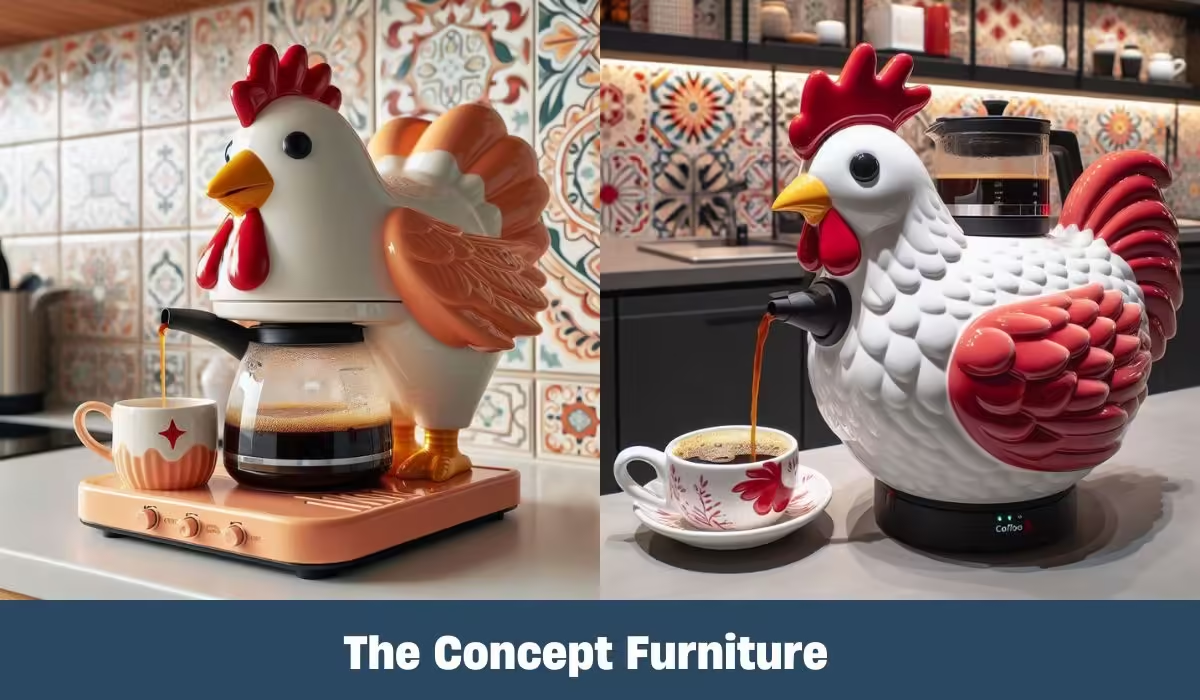The kitchen often serves as the heart of the home, a space where culinary creativity flourishes and family gatherings take place. In recent years, jellyfish kitchen islands have emerged as a captivating design element that not only enhances functionality but also adds a unique aesthetic appeal. These modern kitchen islands draw inspiration from the soft and fluid forms of jellyfish, creating a harmonious blend of art and utility. This article delves deep into the various aspects of jellyfish kitchen islands, exploring their design characteristics, benefits, materials, installation processes, common mistakes to avoid, and more. With a focus on maximizing efficiency and enhancing the overall kitchen experience, this guide aims to provide comprehensive insights into incorporating jellyfish kitchen islands into your home.
Introduction to Jellyfish Kitchen Islands
Jellyfish kitchen islands represent a contemporary approach to kitchen design, merging style with practicality. Their flowing lines and organic shapes evoke feelings of tranquility and elegance while offering ample workspace and storage options. As the demand for innovative and eye-catching kitchen solutions grows, homeowners are increasingly drawn to jellyfish-inspired designs that make a statement.
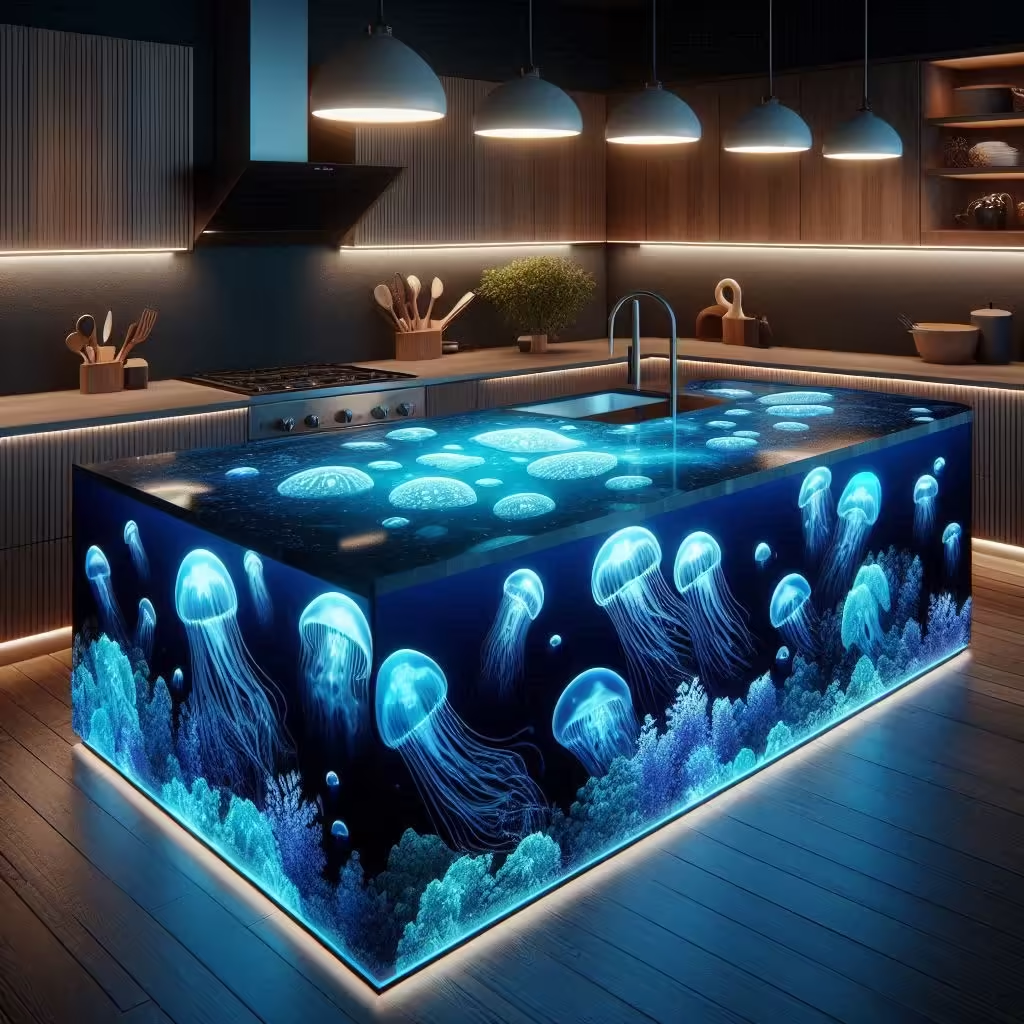
The concept of jellyfish kitchen islands goes beyond mere aesthetics; it embodies a philosophy of bringing nature indoors. By mimicking the graceful movements of jellyfish, these islands create an inviting atmosphere that encourages social interaction and culinary exploration. This introduction sets the stage for an in-depth examination of the various features and advantages of jellyfish kitchen islands, guiding you through the process of selecting, installing, and maintaining such a splendid addition to your kitchen.
Design Characteristics of Jellyfish Kitchen Islands
When venturing into the world of jellyfish kitchen islands, it’s essential to understand their distinctive design characteristics that set them apart from traditional islands. These elements contribute to the overall ambiance and functionality of the kitchen, making them an attractive choice for modern interiors.
Unique Shapes and Forms
One of the most striking features of jellyfish kitchen islands is their unique shapes. Unlike conventional rectangular or square islands, jellyfish-inspired designs often feature rounded edges, flowing contours, and asymmetrical forms. The use of curves introduces a sense of movement, reminiscent of jellyfish drifting gracefully in the ocean.
These dynamic shapes allow for creative layouts, adapting to various kitchen configurations. Whether you have a small, galley-style kitchen or a spacious open-concept layout, jellyfish kitchen islands can be tailored to fit seamlessly within your space. Designers often employ innovative techniques to create custom islands that reflect the individuality of the homeowner while ensuring optimal usability.
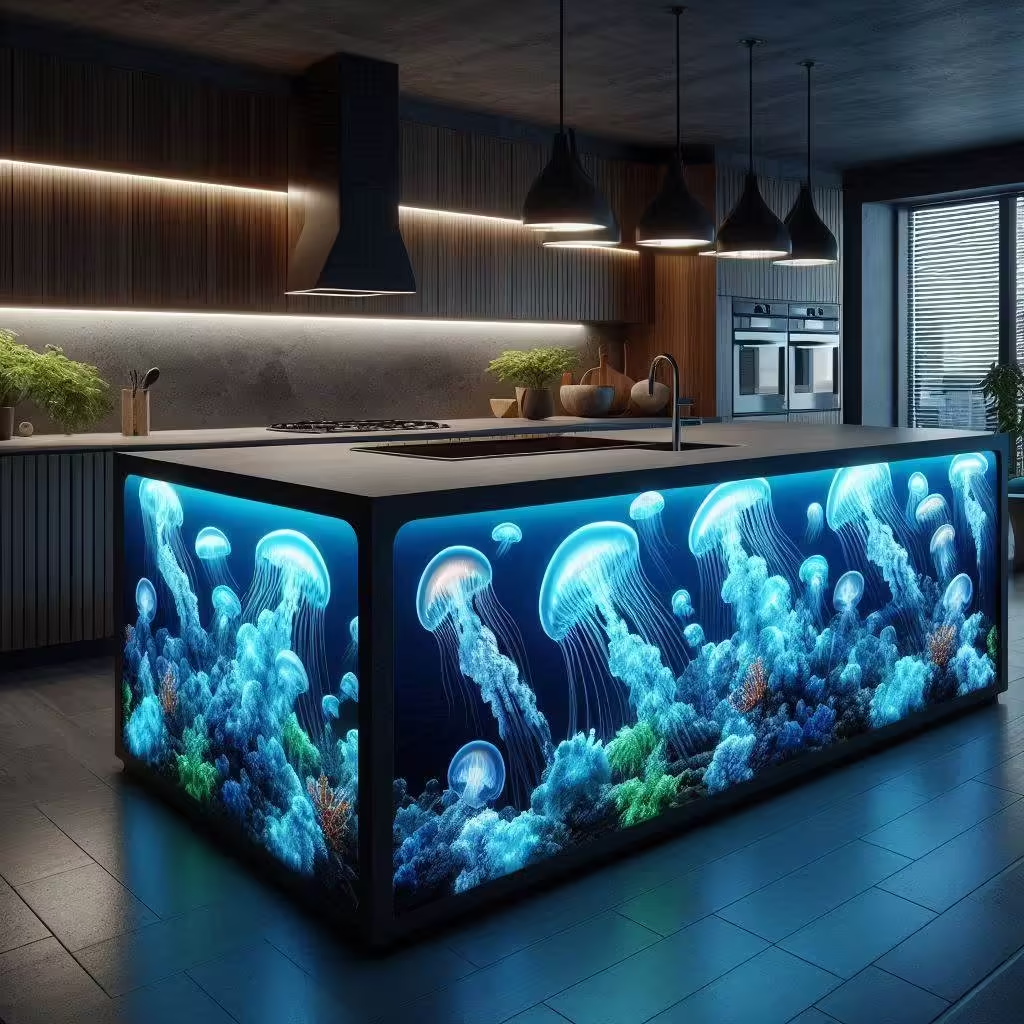
Incorporating unique shapes into your kitchen can also impact how the space feels. Curved surfaces tend to soften the look of a room, promoting a more relaxed and inviting atmosphere. When guests gather around a jellyfish kitchen island, they find themselves naturally drawn to its organic form, encouraging conversations and shared experiences.
Color Variations and Aesthetic Appeal
Color plays a pivotal role in defining the aesthetic allure of jellyfish kitchen islands. Homeowners can choose from a wide palette of colors, ranging from muted earth tones to vibrant shades inspired by marine life. The choice of color not only impacts the visual appeal but can also influence the mood and energy of the kitchen.
A carefully selected color scheme can transform a kitchen into a warm gathering space or a lively cooking area. Soft blues and greens may evoke a tranquil coastal vibe, while bold colors like coral or teal can infuse the environment with energy and excitement.
Beyond solid colors, many jellyfish kitchen islands incorporate intricate patterns and textures that mimic the beauty of underwater ecosystems. Using materials like glass, acrylic, or resin, designers can create stunning visual effects that capture the essence of jellyfish and their natural habitat. Such designs become focal points within the kitchen, showcasing both artistry and craftsmanship.
Benefits of Incorporating Jellyfish Kitchen Islands
Investing in a jellyfish kitchen island offers numerous advantages that extend beyond mere style. These islands enhance the kitchen’s functionality, streamline cooking processes, and optimize spatial arrangements. Here are some key benefits of incorporating a jellyfish kitchen island into your home.
Maximizing Space Efficiency
One of the primary draws of jellyfish kitchen islands is their ability to maximize space efficiency. Many designs incorporate built-in storage solutions, allowing for the organization of kitchen essentials without occupying additional floor space. Drawers, cabinets, and shelves can be seamlessly integrated into the island’s structure, providing easy access to cooking tools, utensils, and pantry items.
Moreover, the multi-functional nature of jellyfish kitchen islands enables homeowners to utilize them for various purposes. They can serve as prep stations, casual dining areas, or even homework zones for children. This versatility allows families to make the most out of their kitchen space, creating an environment that accommodates daily activities and special occasions alike.
Designing the island to match the flow of the kitchen can greatly enhance overall efficiency. When strategically placed, a jellyfish kitchen island facilitates smooth transitions between cooking, cleaning, and entertaining, ultimately simplifying meal preparation and social interactions.
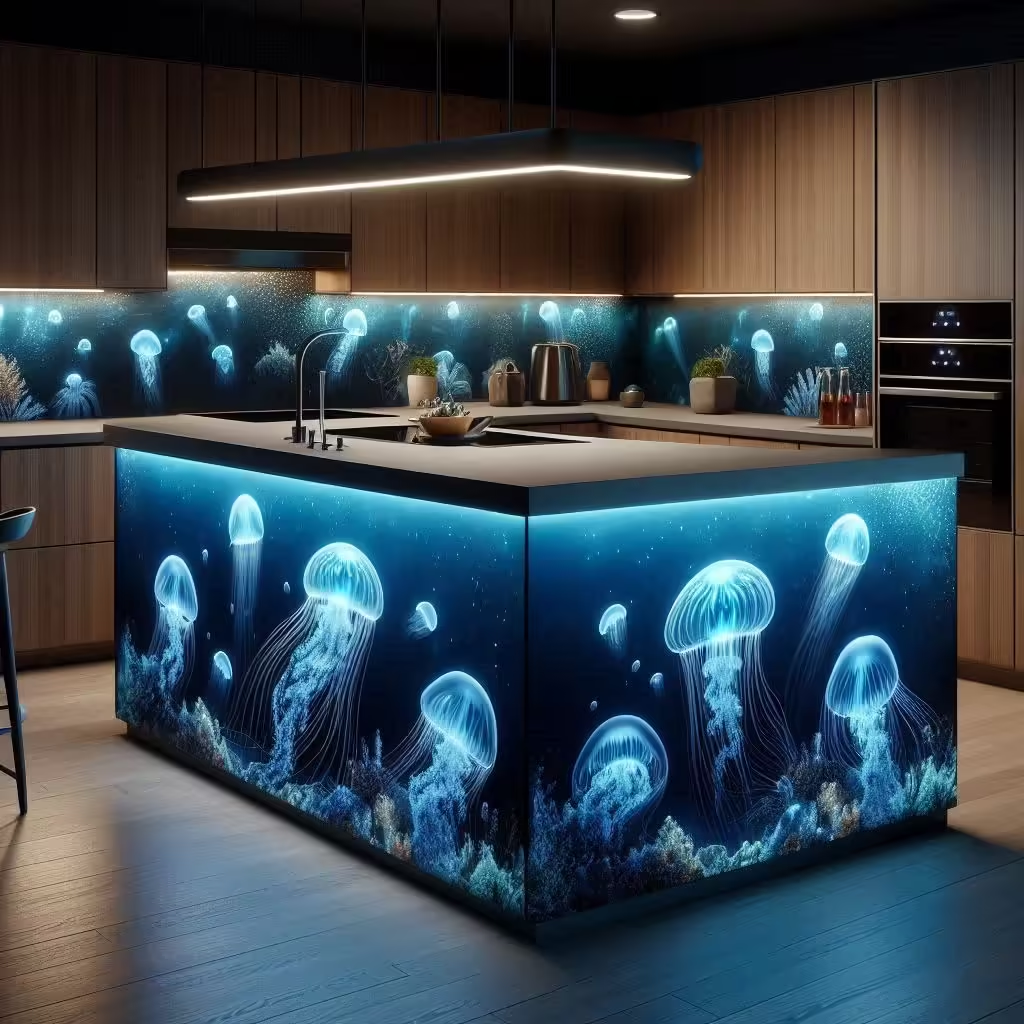
Enhancing Culinary Experiences
Cooking is often seen as a chore rather than a pleasurable activity, but a well-designed jellyfish kitchen island can change that perspective. By introducing a dedicated workspace that inspires creativity, these islands encourage experimentation and culinary adventures.
The expansive surface area of a jellyfish kitchen island provides ample room for food preparation, allowing multiple chefs to collaborate without feeling cramped. Whether you’re chopping vegetables, rolling dough, or assembling dishes, the generous workspace fosters an engaging cooking environment.
Additionally, the seamless integration of appliances within the island further enhances the culinary experience. Built-in cooktops, sinks, and even wine coolers can be incorporated into the design, making everything easily accessible. This level of convenience minimizes the time spent transitioning between different areas of the kitchen, permitting homeowners to devote more time to enjoying the cooking process.
Furthermore, the inviting design of jellyfish kitchen islands encourages family members and friends to partake in cooking activities together. This collaborative spirit nurtures connections and creates lasting memories, transforming meals into opportunities for bonding.
Materials Used in Jellyfish Kitchen Islands
The selection of materials used in jellyfish kitchen islands significantly impacts their durability, maintenance requirements, and environmental footprint. By understanding the various options available, homeowners can make informed decisions that align with their lifestyle and values.
Durability and Maintenance
When investing in a kitchen island, the material chosen must withstand the demands of daily use. Popular choices for jellyfish kitchen islands include quartz, granite, marble, and wood. Each material has its strengths and weaknesses when it comes to durability and maintenance.
Quartz is renowned for its non-porous surface, making it resistant to stains and bacteria. This feature simplifies cleaning, enabling busy homeowners to maintain a hygienic cooking environment effortlessly. Meanwhile, granite and marble offer striking visual appeal and heat resistance, though they require periodic sealing to prevent staining and damage.
For those who prefer a warmer aesthetic, wood can serve as a beautiful choice, lending warmth and character to the kitchen. While it requires more upkeep—such as regular oiling and careful attention to moisture—it can produce a cozy yet elegant look that complements the organic design of jellyfish kitchen islands.
Ultimately, selecting a durable material that aligns with your preferences and lifestyle is crucial for ensuring longevity. Consider how much wear and tear your kitchen island will endure and choose a material that meets those needs while providing visual satisfaction.
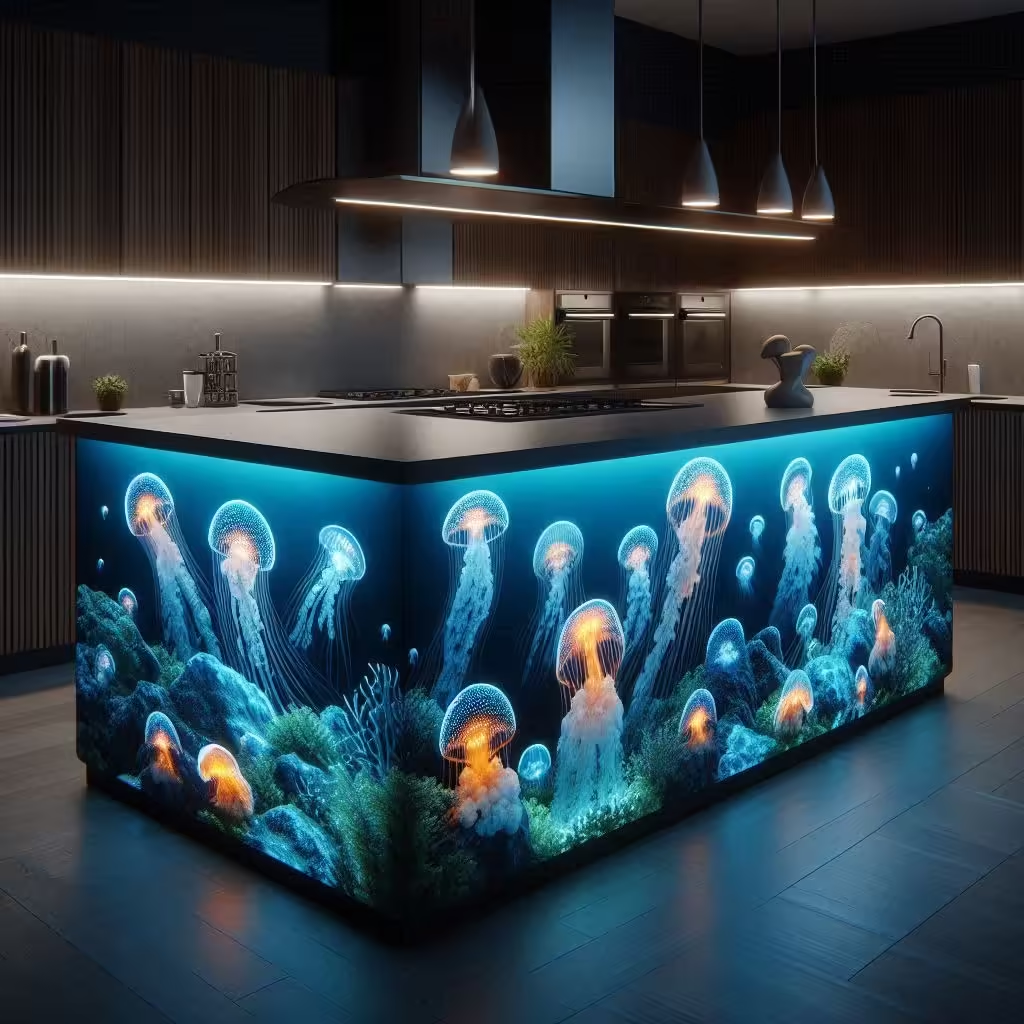
Environmental Considerations
As sustainability continues to shape consumer choices, many homeowners are seeking environmentally-friendly materials for their jellyfish kitchen islands. Eco-conscious options include reclaimed wood, bamboo, and recycled materials that minimize environmental impact while maintaining visual appeal.
Reclaimed wood, sourced from salvaged structures, not only reduces waste but also adds character and history to your kitchen. Each piece tells a story, contributing to the island’s charm. Similarly, bamboo is a renewable resource known for its strength and durability, making it an excellent sustainable choice.
Another innovative option involves using recycled materials, such as recycled glass or composite surfaces created from post-consumer products. These materials reduce landfill waste and promote a circular economy, aligning with eco-friendly values.
By choosing sustainable materials, homeowners can enjoy the beauty and functionality of jellyfish kitchen islands while minimizing their ecological footprint, contributing to a healthier planet for future generations.
Installation Process for Jellyfish Kitchen Islands
Installing a jellyfish kitchen island requires careful planning and execution to ensure that it fits seamlessly within the existing kitchen layout. The installation process can vary depending on whether you opt for a professional installer or decide to go the DIY route.
Preparing Your Kitchen Layout
Before diving into installation, it’s essential to assess the existing kitchen layout and determine the ideal placement for the jellyfish kitchen island. Consider factors such as traffic flow, proximity to appliances, and available space.
Creating a functional workflow is critical; the kitchen should facilitate movement between the sink, stove, refrigerator, and other key areas. Visualizing how the jellyfish kitchen island will integrate into your current setup will help you identify the best location while optimizing efficiency.
Additionally, measuring the designated area is paramount. Take precise measurements of both the kitchen and the proposed island to ensure a snug fit without overcrowding the space. Keep in mind that the jellyfish kitchen island should complement the existing aesthetic while maintaining a balance between style and functionality.
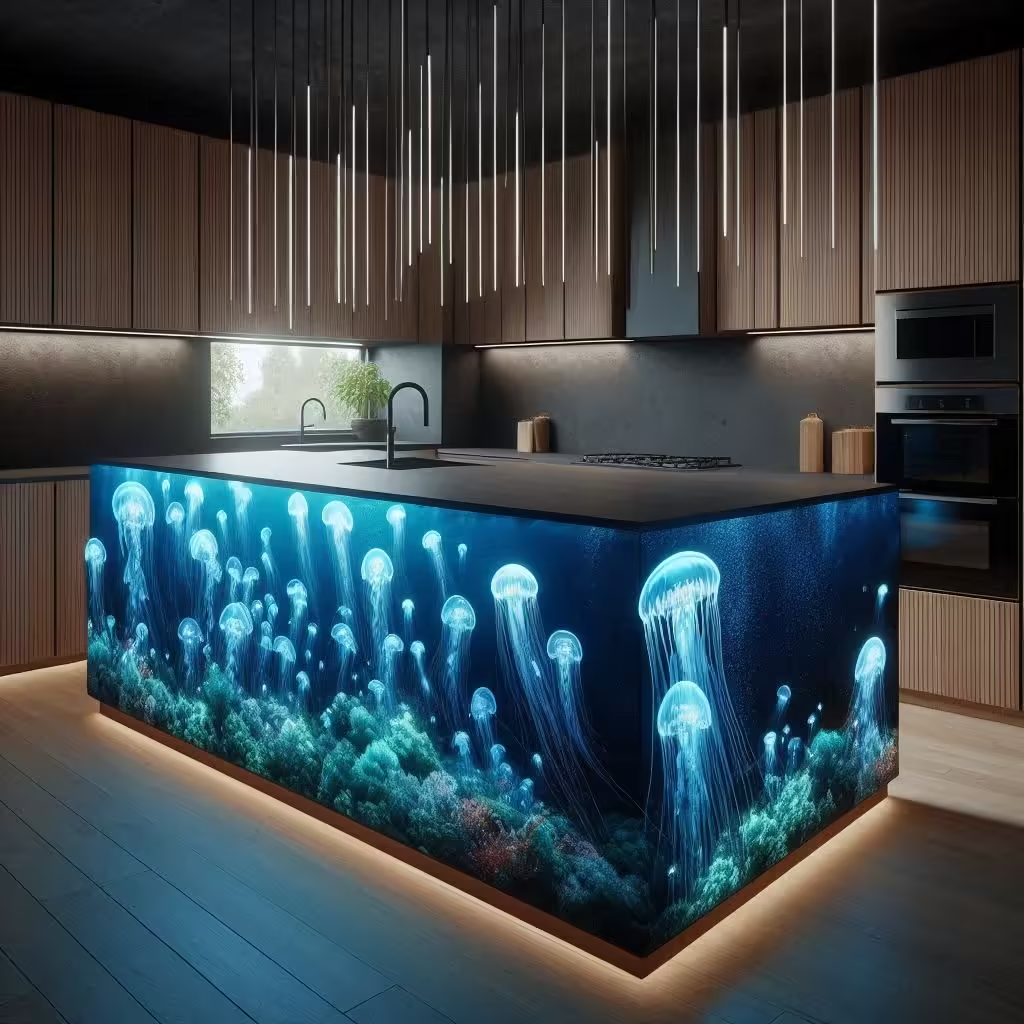
Professional vs. DIY Installation
Deciding between professional installation and a do-it-yourself approach depends on several factors, including your budget, skills, and timeline. Opting for professionals guarantees expertise and ensures that all elements are installed correctly, reducing the likelihood of issues down the line.
Professional installers bring experience to the table, especially when dealing with complex electrical, plumbing, or structural considerations. If your jellyfish kitchen island includes built-in appliances, hiring experts familiar with local building codes is wise to avoid potential complications.
On the other hand, if you possess a knack for home improvement projects and feel confident in your abilities, a DIY installation can be a rewarding endeavor. It allows for greater personalization and flexibility while potentially saving on labor costs. However, it’s vital to research thoroughly and follow detailed instructions to ensure a successful outcome.
Regardless of your choice, maintaining communication with installers or consulting reputable sources will lead to a smoother installation experience.
Notes
While jellyfish kitchen islands offer countless benefits and design possibilities, there are certain notes to keep in mind before proceeding with your project. Attention to detail during planning and customization can make all the difference in achieving your desired results.
Firstly, consider the overall flow and functionality of your kitchen. An island that looks stunning but disrupts the practical layout can lead to frustration in everyday use. Analyze how the island interacts with other elements in the kitchen, ensuring it enhances the cooking and social experience rather than hindering it.
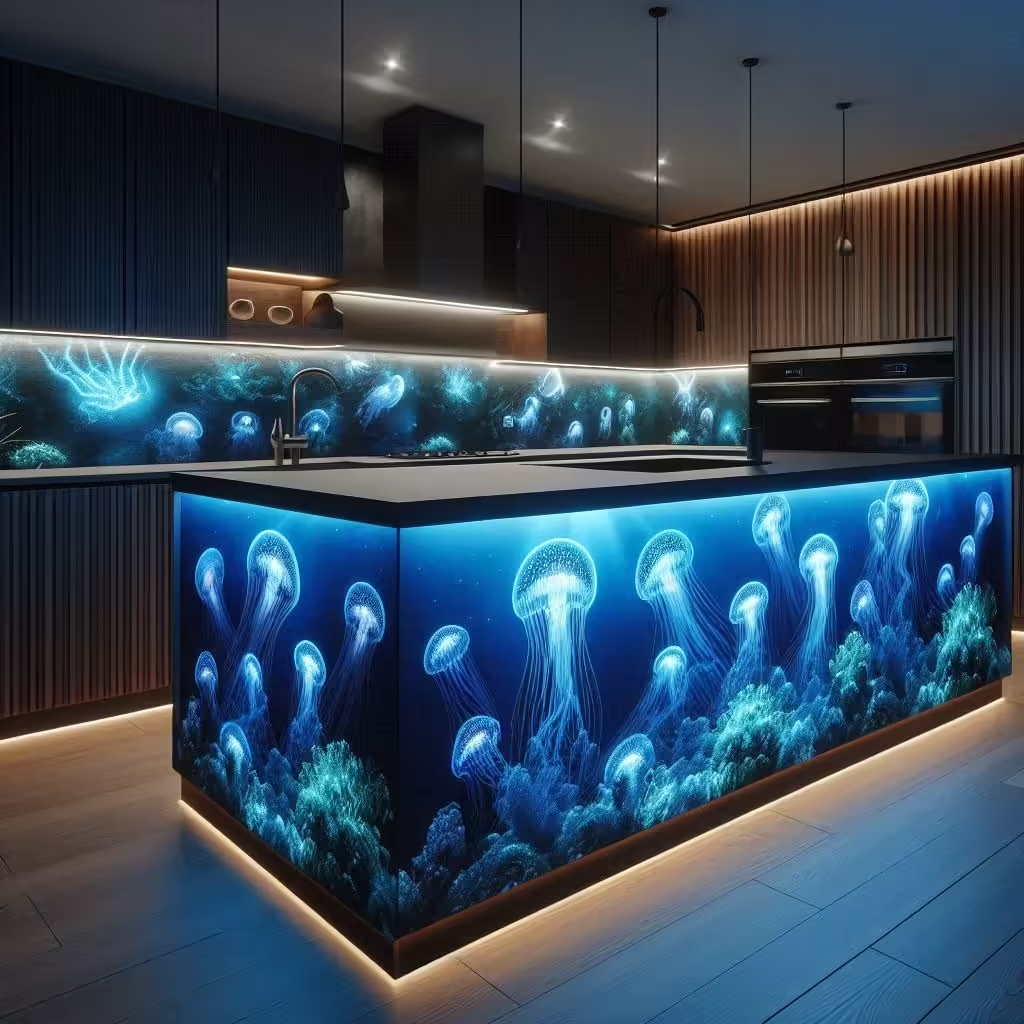
Additionally, think about the long-term implications of your choices. Trends in kitchen design evolve over time; therefore, selecting timeless fixtures and finishes can elevate the island’s longevity. Aim for a balance between trendy elements and classic styles to create a space that remains appealing for years to come.
Lastly, engaging in discussions with family members or anyone else who utilizes the kitchen can provide valuable insights. Different perspectives can reveal preferences and needs you might not have considered, resulting in a more functional and enjoyable kitchen environment.
Mistakes to Avoid
When embarking on the journey of integrating a jellyfish kitchen island into your home, avoiding common pitfalls can save time, money, and stress. Each decision from size to layout contributes to the island’s effectiveness and enjoyment. Here are some mistakes to steer clear of:
Underestimating Size Requirements
One of the gravest mistakes is underestimating the size requirements for a jellyfish kitchen island. It’s tempting to select a smaller island to save space, but this could lead to limited functionality and inadequate workspace.
Consider the number of users and their cooking habits; envision gatherings and meal preparations to gauge how much space will be necessary. An overly cramped island can hinder movement, making cooking less enjoyable, so aim for a size that accommodates your family’s lifestyle while fitting harmoniously within the kitchen’s dimensions.
Moreover, don’t forget to account for clearance space around the island. Allowing enough room for opening cabinet doors, drawers, and walking paths is essential to maintaining a fluid kitchen layout. Prioritizing ample space will cultivate a more pleasant cooking environment.
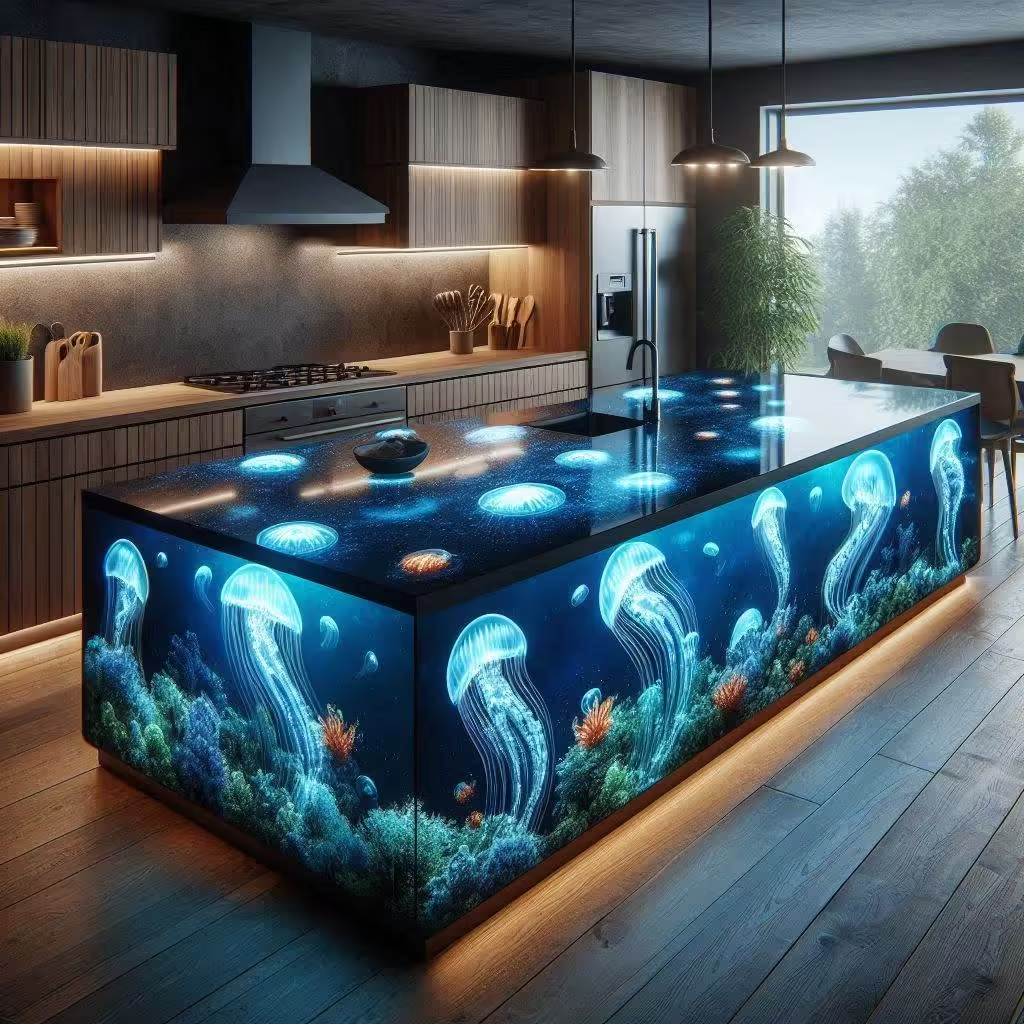
Neglecting Workflow and Functionality
Another common mistake involves neglecting the essential aspects of workflow and functionality. The jellyfish kitchen island should enhance the kitchen experience, not diminish it.
As you plan your kitchen layout, consider how people move throughout the space during cooking and entertaining. Identify the focal points and major components, ensuring that the jellyfish island facilitates smooth transitions between different tasks, such as food prep, cooking, and cleanup.
Incorporating features that align with your cooking style, such as built-in appliances or storage compartments, will augment the island’s functionality. Tailor the design to suit your individual needs while keeping the overall workflow in mind for an efficient and enjoyable kitchen.
Frequently Asked Questions
The world of jellyfish kitchen islands can spark curiosity, leading many homeowners to seek answers to specific questions. Here are some frequently asked inquiries, along with insightful responses to guide you through your decision-making process.
How do I choose the right jellyfish kitchen island for my home?
Choosing the right jellyfish kitchen island requires thoughtful consideration of your lifestyle, preferences, and kitchen layout. Begin by assessing the available space; measure the area to ensure the island fits comfortably without overcrowding the kitchen.
Next, contemplate the intended use of the island. Will it primarily serve as a food prep station, a casual dining area, or both? Identifying your priorities will help you select an appropriate design and size. Explore different materials, colors, and features until you find an island that resonates with your vision and complements your home’s overall aesthetic.
Finally, consider the flow of your kitchen. Look for a jellyfish kitchen island that enhances accessibility and convenience while creating a harmonious transition between various cooking zones.
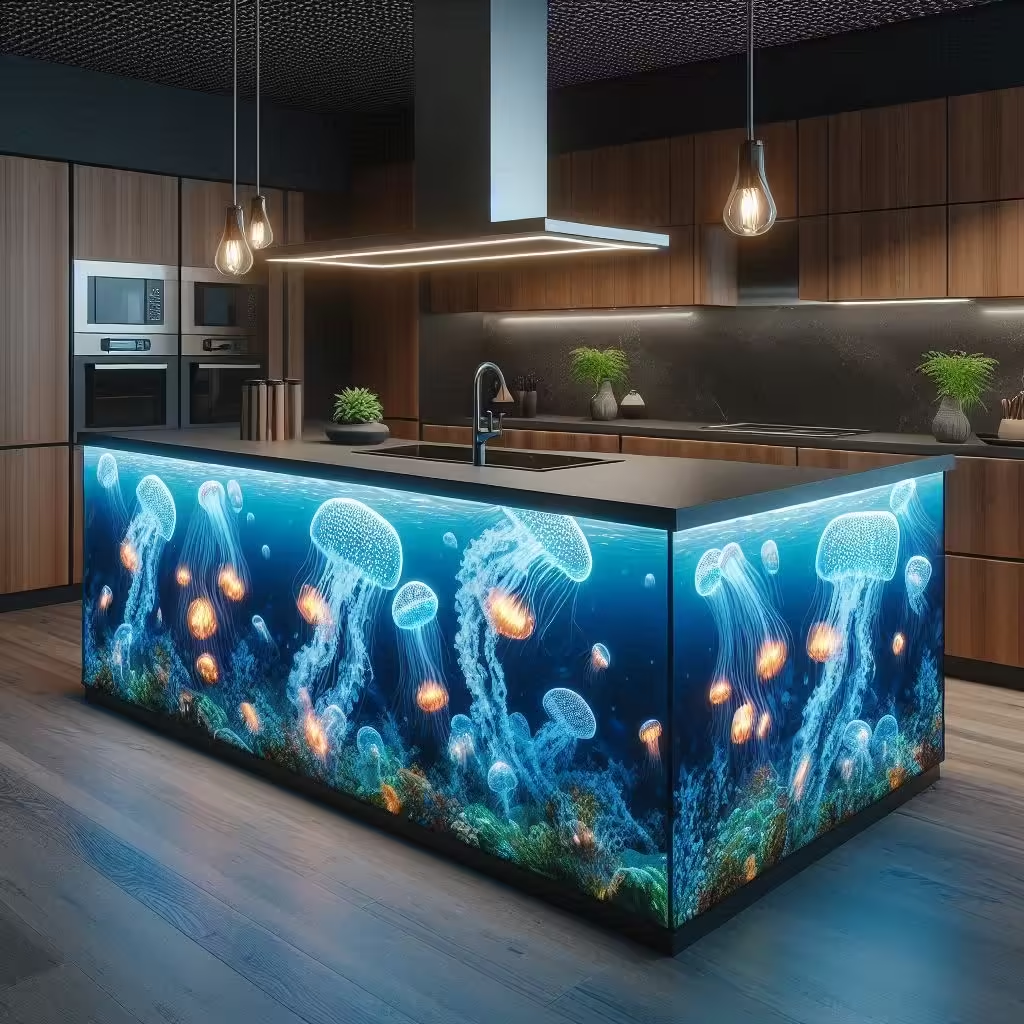
What maintenance is required for jellyfish kitchen islands?
Maintenance requirements for jellyfish kitchen islands can vary based on the materials chosen. For instance, quartz surfaces typically require minimal upkeep, merely needing occasional cleaning with soap and water. Granite and marble, while visually stunning, need periodic sealing and gentle care to protect against staining.
Wooden islands demand more attention, requiring regular oiling and moisture management to prevent warping or damage. Whatever material you choose, establishing a routine for cleaning and maintenance is essential to preserving the island’s beauty and functionality.
In addition to physical upkeep, staying attuned to the evolving trends and kitchen technologies means that you can adapt your jellyfish kitchen island as needed. With the right care, your investment can remain a centerpiece of your kitchen for many years.
Conclusion
In conclusion, jellyfish kitchen islands are more than just functional elements; they embody an artistic expression that elevates the kitchen experience. Through their unique shapes, vibrant colors, and versatile features, these islands inspire creativity and foster connection among family and friends.
From maximizing space efficiency to enhancing culinary experiences, the benefits of incorporating jellyfish kitchen islands into your home are plentiful. As you navigate the installation process, understanding essential considerations and avoiding common pitfalls will ensure a satisfying outcome that reflects your personal style.
Whether you choose to hire professionals or embrace a DIY approach, the joy of designing a jellyfish kitchen island lies in the endless possibilities it presents. By thoughtfully selecting materials, focusing on functionality, and embracing the enchanting design, you can create a kitchen that truly becomes the heart of your home—a space where delicious meals, cherished memories, and meaningful interactions come to life.





